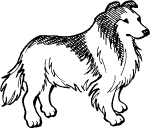 | |
Deaf Dog Education Action Fund |
| Home | | | | | Training | | | Resources | | | Rescue | | | You Can Help |
Frequently Asked Questions
For perhaps, if the truth were known, we're all a little blind, a little deaf, a little handicapped, a little lonely, a little less than perfect. And if we can learn to appreciate and utilize the dog's full potentials, we will, together, make it in this life on earth.
- Charlotte Schwartz
- Introduction
- What Causes Deafness in Dogs?
- How Can You Determine If Your Dog is Deaf?
- What is BAER testing?
- Do Deaf Dogs Have Special Health Considerations?
- Is My Dog An Albino? (Or "Why Are Dogs White?")
- Do I Need a Vibrating Collar?
Introduction
Like dog owners everywhere, we love our dogs. Outside of an obvious physical defect, deaf dogs are just your normal, everyday dogs. They do have a better excuse for not listening than most dogs, but they live in our houses, sleep on our beds, play with our children and ride in our cars. They go for walks, chase balls, bark at squirrels (yes, they do bark), and at the end of the day, they collapse in front of the TV with the rest of the family. They share our lives, and are our companions and friends.

A person who has just discovered that their dog is deaf (or is considering the adoption of a deaf dog) will often be faced with the negative warnings of well meaning friends and misinformed experts. Too many spread horror stories about aggressive, biting, deaf dogs that couldn't be trusted or trained, and would eventually break our hearts. These pages (and others on this site) are here to counteract this misinformation.
This FAQ is here to provide information and support for those who find themselves involved with a deaf dog, either as an owner, breeder, trainer, rescue group, or medical professional. It covers many of the most commonly asked questions about deaf dogs, and is continued on the Myths page.
Return to index
What Causes Deafness in Dogs?
What causes a dog to lose its hearing? A lot of the same things that cause hearing loss in humans. Genetic defects can cause a dog to be born deaf; this is known as congenital deafness. A dog can also lose its hearing due to an ear infection, injury to the ear, or may experience gradual (or sudden) hearing loss due to old age. Exposure to loud noise can cause temporary or permanent hearing loss, as can certain drugs.
 The most common cause of congenital deafness is pigment related. (There is some talk about a recessive gene as well, but most researchers do not believe this is the case.) Some dogs have white coats, but still have pigmented skin (Samoyeds, West Highland Terriers, and White German Shepherds fall into this category). Although they have white fur, they have black noses and eye rims (their fur is actually not pure white, but a very light buff color). Other dogs normally have colored coats, and white trim (this includes Dalmatians; the white is actually not their real coat color, the "spots" are). The "trim" comes from areas of unpigmented (pink) skin, which produces white hair. If there is unpigmented skin in the inner ear, the nerve endings atrophy and die off in the first few weeks of the puppy's life, resulting in deafness. Please note that you cannot tell the color of hairs in the inner ear by looking at any visible part of the dog's ears (including the hair around the ear canal). Although many dogs with white hair on their ears will be deaf, many deaf dogs have colored ears as well.
The most common cause of congenital deafness is pigment related. (There is some talk about a recessive gene as well, but most researchers do not believe this is the case.) Some dogs have white coats, but still have pigmented skin (Samoyeds, West Highland Terriers, and White German Shepherds fall into this category). Although they have white fur, they have black noses and eye rims (their fur is actually not pure white, but a very light buff color). Other dogs normally have colored coats, and white trim (this includes Dalmatians; the white is actually not their real coat color, the "spots" are). The "trim" comes from areas of unpigmented (pink) skin, which produces white hair. If there is unpigmented skin in the inner ear, the nerve endings atrophy and die off in the first few weeks of the puppy's life, resulting in deafness. Please note that you cannot tell the color of hairs in the inner ear by looking at any visible part of the dog's ears (including the hair around the ear canal). Although many dogs with white hair on their ears will be deaf, many deaf dogs have colored ears as well.
Hearing loss affecting both ears is called Bilateral Deafness. A bilaterally deaf dog is completely (or mostly) deaf in both ears. Hearing loss occurring in, or affecting only one ear, is called Unilateral Deafness. A unilaterally deaf dog has hearing loss in only one ear and has full hearing in the other ear.
Return to indexHow Can You Determine If Your Dog is Deaf?
The only way to know for sure if your dog is deaf is with a BAER test (see below). If you are unable (or unwilling) to have this test done, it is usually possible to make an accurate determination by observing the dog or talking to your vet and other "dog professionals." Most of us never have any doubts.
Some of the early signs (while the pup is still in the litter) may include the deaf pup that plays more aggressively or bites too hard because it is not deterred by the other puppy's yelp of pain. Once weaned, a deaf puppy may not wake up at feeding times unless it feels vibrations, or is bumped by a littermate.
 In the home, you may notice that it doesn't respond to being called (or other noises), when sleeping, too far away, or not looking at you. Sometimes it bites too hard when playing with the family. (Yes, it is possible to teach a deaf dog to have a soft mouth.) Just as in the litter, if you own another dog, it can be difficult to immediately determine if the pup is deaf as it will notice what the other dog does and tag along. The following are some simple tests you can try at home if you suspect that your dog is deaf. Remember that it is almost impossible to test a unilaterally deaf (deaf in one ear) dog at home with any certainty.
In the home, you may notice that it doesn't respond to being called (or other noises), when sleeping, too far away, or not looking at you. Sometimes it bites too hard when playing with the family. (Yes, it is possible to teach a deaf dog to have a soft mouth.) Just as in the litter, if you own another dog, it can be difficult to immediately determine if the pup is deaf as it will notice what the other dog does and tag along. The following are some simple tests you can try at home if you suspect that your dog is deaf. Remember that it is almost impossible to test a unilaterally deaf (deaf in one ear) dog at home with any certainty.
Keep in mind that when doing these tests, the louder the sound, the stronger the vibration. (Remember how a stereo can rattle the house?) Any vibration or air current that the dog detects can, and probably will, get a response that makes you think that the dog can hear. A unilaterally deaf dog should hear the sounds, but not be able to tell where they originated. It may look around (even looking away from the source) to see where the sound came from. While trying these tests, be sure your dog is not looking in your direction, or in the direction of the distraction. You can also try a test when your dog is asleep. If necessary, have someone hold the dog facing away from you.
Tests You Can Do At Home
- Jangle keys, a rattle, or a can of coins
- Squeak a toy (be sure that air from the toy doesn't hit the dog - try it behind your back)
- Call your dog in a normal voice - try yelling
- Clap your hands (you should be far enough away so that he doesn't feel air movement)
- Whistle or (if you're musically challenged) blow a whistle
- Turn on a vacuum cleaner (be sure it's far enough away from the dog so that the vibrations or airflow don't reach him)
- Bang two pots together (be careful of air vibrations reaching your dog)
- Ring a bell or have someone ring your telephone or doorbell
Remember that if the dog is unilaterally deaf, you will get a different response depending on which side it is sleeping on or from what angle the sound has been directed. Some deaf dogs may hear very low or very high-pitched sounds. They may perk up, look around and have an expression on their face that asks, "What was that?" This could be an advantage if it's true for your dog - try using a dog whistle and see if you get a response to it.
If your dog doesn't hear normal sounds at normal volumes, chances are that it is deaf. Ask your vet or trainer if you feel the need for a second opinion. Like we said before, the only way to know for certain is to have the dog BAER tested.
Return to indexWhat is BAER testing?
A BAER test is the only 100% reliable method for determining that a dog is deaf (or for measuring the extent of its hearing loss). BAER (pronounced "bear") stands for "Brainstem Auditory Evoked Response" and is a procedure using computers to record the electrical activity of the brain in response to sound stimulation. This is the same test used to check the hearing of human infants, and measures the same range of hearing. This means that the test does not measure the full range of canine hearing, but it will tell you if your dog has hearing within the normal human range (some dogs will test as "deaf," but will still be able to hear very high pitches).
 The test is not painful and can be performed on any dog over six weeks of age. (A puppy's ear canals don't open until they are about two weeks old.) Sedation is usually not necessary, but some dogs (especially puppies) don't like being restrained, or having wires hang from their face, so it can be performed while the dog is sedated. A clicking sound is directed into the ear through a foam insert, earphones, or headphones and the brain's response is recorded. Each ear is tested individually and the test generally lasts for only 10 to 15 minutes. You can see pictures of puppies being tested, and what the printout results look like at this site - Dalghani Tibetan Terriers - Deafness and BAER testing.
The test is not painful and can be performed on any dog over six weeks of age. (A puppy's ear canals don't open until they are about two weeks old.) Sedation is usually not necessary, but some dogs (especially puppies) don't like being restrained, or having wires hang from their face, so it can be performed while the dog is sedated. A clicking sound is directed into the ear through a foam insert, earphones, or headphones and the brain's response is recorded. Each ear is tested individually and the test generally lasts for only 10 to 15 minutes. You can see pictures of puppies being tested, and what the printout results look like at this site - Dalghani Tibetan Terriers - Deafness and BAER testing.
Since BAER testing is only available at select facilities and can be expensive, many people choose to rely on their own experiences with the dog and the opinion of their veterinarian in making the determination. For their own peace of mind, or because they are breeding a "high-risk" dog (like the Dalmatian), others insist on this testing. A complete list of BAER testing facilities can be found on Dr. George Strain's web page, www.lsu.edu/deafness/baersite.htm. (Dr. Strain has done a lot of research on the causes of canine deafness, and has found a few of the answers. Unfortunately, most of his writings recommend euthanizing deaf dogs. This is an opinion, not based on research, and should be taken as such.)
In general, that is the only test that a dog can't cheat on. In spite of the rumors that deaf dogs are handicapped and can't function normally, they are some of the most adaptable and inventive creatures we know. As puppies, they learn to queue off the actions of their littermates. They are very attuned to movements and changes in light. They recognize vibrations (which is all that sound really is) and they sense the change in airflow or pressure that results from opening or closing a door. The same is true for dogs whose loss of hearing is gradual because of age or a prolonged illness. They just never admit to us that they cannot hear. Congenitally deaf dogs don't know that they are missing anything. How could those cute puppies be anything less than perfect?
Return to indexDo Deaf Dogs Have Special Health Considerations?
For the most part, no. There is only one special health consideration that applies to all deaf dogs. You need to find a veterinarian who will believe, as you do, that your dog deserves to live. Unfortunately, there are still vets who believe what they are told by the various breed clubs and other sources, and who will not be supportive of you and your dog.
A concern for many deaf dogs is sunburn. Any dogs (not just deaf ones) with a predominantly white coat frequently have pink skin which is prone to sunburn (noses in particular). This is especially true if the dog also has a short coat, but even longer coated dogs will generally have shorter hair on their faces. It is important to minimize their exposure to intense sunlight, and you may want to consider sunscreen. Look for one meant for people with sensitive skin (or babies) and preferably unscented. You can sometimes find sun block made just for dogs. The thicker, stick-type works quite well on noses and other sensitive areas.

Some deaf dogs are homozygous merles (both of their parents were merle dogs, and they inherited a copy of the gene from each parent). For a description of merle, see 'Is My Dog An Albino? (Or "Why Are Dogs White?")' below. There are many breeds affected by this, including Australian Shepherds, Great Danes, Catahoula Leopard Dogs, Dachshunds, Shetland Sheep Dogs, and Border Collies. Mix-breed dogs can also be homozygous merles if both parents were merle in color. Homozygous merles, also called double merles, excessive whites and (inaccurately) lethal whites (this is considered a derogatory term by many people with double merles), are frequently mostly white in color.
Although you may hear otherwise, the only known health problems proven to be associated with being a homozygous merle have to do with hearing and vision. Stories abound about vague "internal organ" problems (including heart, liver, and pancreas), or allergies, or immune system problems, or a shortened life span. The fact of the matter is that many of their normally pigmented kindred suffer from the same problems (and if you do have a double merle with any of these problems, odds are that the littermates do as well - most living double merles do not come from breeders where health is a primary concern). Double merles can be deaf (not all are, though) because of the lack of pigment in their inner ear (see above for an explanation of the causes of deafness). It is possible for a dog with only one merle gene (heterozygous) to look just like a double (see below reasons for a dog to have excess white in its coat), but they will not have the eye problems (so if your dog's eyes do not show any defects, it probably is not a double).
Homozygous merles, whether deaf or not, may have a variety of eye defects. These can occur in any color eye, but are illustrated here in blue just because it is easier to see. The cells that grow to become eyes are located in the same place that color starts in the embryo (during early development). All of their other organs begin in a different location, and so are not affected by this genetic combination. Some of the eye problems are noticeable, such as an irregularly shaped pupil. Instead of being a normal round shape, this opening in the center of the iris may have spiky projections ![]() (called a "starburst" pupil) or jagged/irregular edges
(called a "starburst" pupil) or jagged/irregular edges ![]() ("eccentric"). These conditions are not the same as colobomas, which can happen in a dog (or human) of any color or pattern. This condition can make their eyes very light sensitive if the pupil doesn't react to light as well as it should. Be aware that some dogs will have a halo of darker color around their pupil, which can resemble these last two conditions, so look closely to be sure of what you are seeing (and often it is best to get the opinion of an ophthalmologist ). Their pupils can also be off center
("eccentric"). These conditions are not the same as colobomas, which can happen in a dog (or human) of any color or pattern. This condition can make their eyes very light sensitive if the pupil doesn't react to light as well as it should. Be aware that some dogs will have a halo of darker color around their pupil, which can resemble these last two conditions, so look closely to be sure of what you are seeing (and often it is best to get the opinion of an ophthalmologist ). Their pupils can also be off center ![]() ("subluxated"), where the pupil is not centered in the eye (usually it is lower than it should be). This doesn't seem to bother them unless the pupil is very low in the eye (just slightly off-center seems to be easier to cope with). Microphthalmia, or an abnormally small eye,
("subluxated"), where the pupil is not centered in the eye (usually it is lower than it should be). This doesn't seem to bother them unless the pupil is very low in the eye (just slightly off-center seems to be easier to cope with). Microphthalmia, or an abnormally small eye, ![]() is the most common eye defect seen in homozygous merles (this can vary from just noticeable to appearing to have no eye at all). Usually, the smaller the eye, the more of the third eyelid that is permanently visible. Other defects are within the eye and require the special equipment of a veterinary ophthalmologist to diagnose. Many dogs will have multiple eye defects, and most of those will have some visual loss, sometimes to the point of blindness. This may not be obvious to the casual observer as most dogs can compensate very well for their vision limitations, especially in a familiar environment. The defects are generally stable, so if a dog has functional vision, it will probably not change (unless affected by another condition).
is the most common eye defect seen in homozygous merles (this can vary from just noticeable to appearing to have no eye at all). Usually, the smaller the eye, the more of the third eyelid that is permanently visible. Other defects are within the eye and require the special equipment of a veterinary ophthalmologist to diagnose. Many dogs will have multiple eye defects, and most of those will have some visual loss, sometimes to the point of blindness. This may not be obvious to the casual observer as most dogs can compensate very well for their vision limitations, especially in a familiar environment. The defects are generally stable, so if a dog has functional vision, it will probably not change (unless affected by another condition).
As with any hearing dog, a deaf dog might go blind from a variety of causes, including old age, injury or disease unrelated to deafness. Whether their impairment started at birth like the homozygous merles or occurred later in life, deaf and blind dogs can lead happy lives in the right home. Special care must be taken to protect them from hazards they are unaware of and they require training techniques suited to their abilities. See our Other Links page for more information. Remember though, that not all double merles are deaf, and not all are blind (and very few are both). See an interesting observation about double merles at Clan Duncan Shetland Sheepdog Growl Pages, Seeing Double.
Return to indexIs My Dog An Albino? (Or "Why Are Dogs White?")
Some people refer to mostly white deaf dogs as "albino" or "part-albino." The term albino is often used as if it just means "white," but the facts are somewhat more complicated. In actuality, there are degrees of albinism (although "part" albino, i.e. white with patches of full pigment, is not possible). A "complete" albino (pure white) has no pigment (not even skin spots). Their skin is a very pale pink, and their eyes are usually pink as well (this is called tyrosinase-negative). Even though this is what is usually thought of as albino, dogs with this genetic pattern are very rare, and likely to be deaf (since they have no pigment at all). There are other forms of albinism (called tyrosinase-positive) that are not really white (they will be an even all-over light gray or pale cream instead). The West Highland White Terriers and white Dobermans fall into this category. Since these dogs do have pigment, they are not usually deaf (see Causes of Deafness above.) To read more on this subject, see Coat Color Genetics (a bit technical, but albinism is discussed) or White Dobes (really technical).
There are many genetic factors that can cause a dog to have a lot of white in its coat (try looking at Dog Genetics Links On the Web for more information on various breeds). Many dogs will have more than one factor at work as well.

In Australian Shepherds, Dachshunds, some Great Danes, Corgis, Shetland Sheepdogs, Collies, Catahoulas, and others, it is caused by inheriting two Merle (Dapple) genes instead of one. Merle is not actually a color, it is a pattern (Merles can come in many different colors). Merle is a dominant gene, it is nearly always visible when the dog has it (if it were recessive, only dogs carrying 2 copies would be merled, and this is not the case). Having one copy of the Merle gene causes irregularly-shaped patches of color on a background that is a lighter shade of the original color. Merle can have many variations; some dogs will be mostly the original color with very little Merling, while others will have small patches of the original and be mostly Merled. The Merling can also vary from very light to almost as dark as the original color. Having 2 copies of the gene doubles this effect, and causes some of the coat to turn white (parents with a lot of white trim tend to produce double pups with more white than those with little to no white). Double Merles will not always be deaf. If the excess white does not affect inner ear pigmentation, they will be able to hear (or only have minimal hearing loss). See above Do Deaf Dogs Have Special Health Considerations? for more information on Double Merles.

Great Danes also have the Harlequin gene. The Harl gene changes a lot of the base coat (whatever color it may be) to white, with irregular splotches of the base coat color showing through. In essence, the Dane coat color is whatever it is (usually black, although other colors and patterns sometimes appear as well) and the Harl gene modifies where that color can appear. In order for the Harlequin gene to "work," the dog must also be carrying the Merle gene (it is possbile that Harlequin simple removes the Merling from the dog's coat, but this isn't known as a fact). A "Merlequin" might simply be Double Merle (no Harlequin), but it's also possible that the Harl gene has incompletely modified the Merle, and so the dog still shows some Merle. It is also possible that very lightly marked Harls are doubles with the Harlequin gene, but they could be singles with very little color left as well (this coloring could also be caused by a white trim gene, see S^w below). There is still a lot that is not known about Harlequin.
In addition to the above, there are several types of white trim that can affect a dog's appearance. Each of these genes are listed separately, but since genes always come in pairs, some can (and will) double up, and there are other modifiers of coat pattern as well. (Note that these patterns are assumed to be separate genes, but this is not a proven fact yet.)

The first white color pattern called "Irish Spotting" (S^i - typical "Lassie" white markings) that is not related to deafness (even when the dog has 2 copies of it), since it is very minimal and doesn't extend into the dog's ears. Besides Collies, it is also carried by the Boston Terrier and Basenji (to mention just a few).

The second white pattern is commonly seen in Beagles (and other hounds), Bulldogs, Cocker Spaniels and English Setters (and other breeds as well). It is called the Piebald Spotting Gene (S^p - non-symmetrical random white pattern). This pattern does not always cause deafness, it is only a problem when the inner ear is missing pigment (see "What Causes Deafness in Dogs?" above).

Dalmatians, Boxers, Bull Terriers, Great Pyrenees, and possibly Mantle/Boston Great Danes (this is not known for certain) are examples of the Extreme White Spotting (or Extreme Piebald) Gene (S^w). When the other half of the gene pair is a solid, the dog will have a white blaze, collar, and white legs (known as "flashy" in Boxers). If two dogs with this pattern are bred, 25% of the pups will be almost all white (known as "pattern white," or "color headed white"). Sometimes these dogs will be deaf, and sometimes not, depending on where the pigment ends up. Dalmatians are homozygous for this gene (carry 2 copies), with the spots in the coat being caused by the ticking gene (which can combine with any of the other white trims as well).
So there are many ways for a dog to have more white in its coat than it should. Sometimes it is just a guess as to why a dog has the pattern that it does, and there is still a lot of research being done in this area.
Return to indexDo I Need a Vibrating Collar?
Not unless you or the dog really wants one (the majority of deaf dogs and their people do just fine without them). The vibrating collar is a paging system for the dog and its owner. It is not the same as an electronic or shock collar. We recognize that the shock from these collars is (or can be) very mild, but it's not an approach we will recommend. After all, even though a static shock from someone scuffing their feet along the carpet is not "painful," it isn't pleasant either. We want to teach the dog to "check in" with us and we want that to always be a happy thing for the dog.

The biggest drawback to the vibrating collars currently available is their weight. The collars weigh between 2.3 to 7.8 oz (65g to 221g) and are really too heavy for smaller dogs (or puppies) to wear comfortably. Think about it: if the dog weighs only 20 lbs. (9 kgs), it would be like having a 2.3 pound (1 kg) weight around the neck of a 150 lb. (68kg) person. What fun would that be?
A vibrating collar does not really teach your dog to "do" anything. It is a cue to "look at me" or "watch me." It is an attention getter (like calling the dog's name) and if you haven't established good basic training with your dog, what will you do once you get its attention?
The collars available today come with a number of available features. If you choose to use one, be sure that it will fit with your planned usage and lifestyle. If it is a combination vibration/shock system, make sure that the shock setting can be turned off. Check the range and the collar's resistance to water. Many of the collars have a tone feature that may seem pretty senseless on a deaf dog. But, just like finding your misplaced keys or TV remote, the tone can serve a purpose if you need to track down a sleeping (or otherwise occupied) pet.
If you are interested in more information on vibrating collars, we have a page on Training With A Vibrating Collar as well as another with a List of Vibrating Collar choices.
Return to index| Home | | | | | Training | | | Resources | | | Rescue | | | You Can Help |
© Copyright DDEAF, 1998-2024